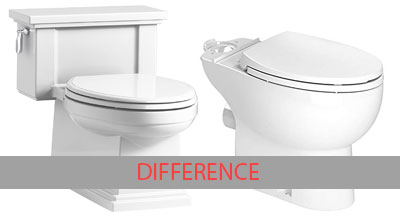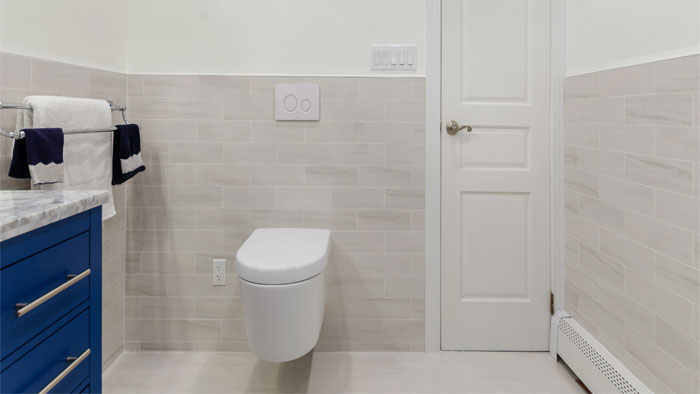When building your dream home or renovating your bathroom, the toilet is one aspect that you must consider. Its quality, design, and looks will surely add some pizzazz to your existing décor.
Like other commodities, toilets too come in different designs and shapes. For instance, when it comes to drainage, standard toilets empty waste through a drain pipe channeled into the floor.
However, there are also rear outlet toilets also called backflush, back outlet, or rear discharge toilets that empty waste through a drain pipe that is channeled into the wall and not in the floor.
Backflush toilets, while uncommon, are quite appealing for high-rise buildings where floor plumbing is both expensive and intricate.
But it’s not just that. You see, sometimes digging into your pristine floor can be super scary for modern private homes. It would be a relief to use a rear discharge toilet where the drain pipe hides behind the toilet. The good thing about is that any disgracefully done spots are hidden allowing your décor to reign.
There is also one more instance where installing a back outlet toilet would be better than a conventional model; an empty room. Get this; it can be hard and costly to redo plumbing in a room that you had not intended to serve as a bathroom. So, the easy way round would be to opt for a rear outlet toilet.
Inner Workings of a Rear Flush Toilet
Like we said before, backflush toilets empty waste through a drain pipe that passes through the wall behind the toilet and into the main sewer line. Because of this design, rear flush toilets cannot depend on gravity to flush. This is the reason why most of them are pressure-assisted toilets.
If you check inside their water tank, you can sport a pressure vessel that utilizes the main water line pressure to deliver a reliable powerful flush. For this reason, you will find rear discharge toilets to be pretty.
Wall-mounted Toilets Vs. Back Flush Toilets

Because of the drain pipe location, it is easier to confuse back flush toilets for wall mounted. However, some differences do exist.
Wall hung toilets, as the name suggests, are suspended on the wall with the water tank hidden inside a thick bathroom wall. So basically, wall-mounted toilets are two-piece toilets but only the bowl is visible thus occupying less space. These toilets are ideal in modern bathrooms with small spaces.
Back outlet toilets, on the other hand, sit on the floor with the water tank clearly visible. The toilets can either be one-piece or two-piece models.
The Difference Between Floor Outlet Toilets and Rear Outlet Toilets

Floor outlet toilets, as we mentioned, are the ones you see in most residential homes. They are mounted on the floor with the drainpipe underneath. Between the drain and bowl lies a flange and wax ring that seals this connection ensuring there are no leaks.
As for the rear outlet toilets, there is no wax ring or flange involved. The toilet bowl is held on the ground with nuts and bolts and a seal of silicone applied around the edges of the bowl. This ensures zero chances of water leaks. The drain pipe in the wall is attached to the bowl’s waste exit vent with a pan connector.
What to Know Before Buying a Rear Outlet Toilet
The unique nature of rear outlet toilets doesn’t make them completely different from conventional floor outlet toilets. So while shopping for them, you still need to consider the same things as other common toilets (with a slight variation here and there). Here is everything you might want to keep at the back of your mind before shoving out your credit card:
Complete Kit
Some toilets including back outlet systems come as a single kit. With the bowl only, you’ll still need to hit online streets in search of a compatible tank and seat. Quite frankly, this can be a lot of work and there is no telling you’ll get compatible parts. To spare yourself this headache, consider kits that come complete.
Water Consumption
No matter how fancy and high quality your rear discharge toilet is, it will be a burden to you and the environment if it doesn’t conserve water. Of course, those monthly water bills may look manageable but over time, that figure can grow to a scary level.
In most countries, toilets are expected to flush waste at a max rate of around 1.6 gallons per flush. To add to that, dual flush toilets let you flush solid and liquid wastes differently thus contributing to better water use and lower bills.
Flushing Technology
Like we said before, because of the location of the drainpipe, most back flush toilets are pressure- assist. But not all companies will explain to you that such toilets with gravity flush mechanisms will operate inefficiently. The same goes for siphonic and washdown systems. So while pressure-assist models will be noisy, waste is eliminated completely.
Trapway Size and Design
You might probably know about flushing technologies, bowl designs, and material structure. However, you probably don’t know or care about the trapway. A trapway is the hole in the bowl that waste passes through.
The size and design of the trapway can affect flushing performance. This is why many high-end toilets feature not only a glazed but large, 3-inch trapway that effortlessly lets waste smoothly glide into the drainage. Even in times when the water pressure seems to be too low.
Bowl Design
Don’t buy an elongated toilet or round model just because another favorite person of yours has one. Round bowl toilets are cheaper, easier for kids to use and space-saving. But the bad news is, the design is not comfortable for adults. But if you are hoping to save on your little restroom space, then consider round bowl toilets.
An elongated toilet is comfortable for many people including kids. But because they are the most common installations in many homes, they do come at a slightly higher price. Read more on elongated vs. round bowl toilets to find out which one is aligned to your needs.
Other things like price, smart features, material, and compatibility must be considered as well when looking for the best rear outlet toilets.
Pros
- Ideal for tall buildings
- Powerful flushing performance
- Versatile with some choice including macerating models
- Minimal to no remodeling, demolishing, and plumbing work
Cons
- They flush loudly
- The P-trap connection is visible and this can upset some people
Wrap Up
The uniqueness of rear outlet toilets demands that you put in a little more effort to understand them before investing in one. These toilets obviously have so many advantages, especially for those building high-rise towers.
Truth be told, many of them are hard to find and others have been discontinued. But with a little effort, you should be able to find them. Another gloomy news is that because their drainage pipe connection goes into the wall, DIY-stars are going to find repairs not so easy-especially if it involves plumbing. All in all, we wish you the best as you search for your next toilet upgrade.
Related Resources:

